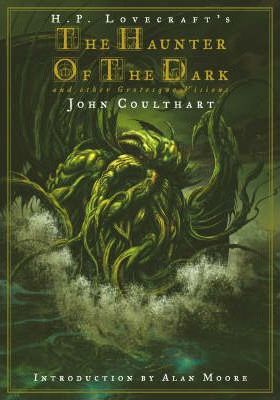 By JOHN COULTHART, H.P. LOVECRAFT, ALAN MOORE (Creation; 2006)
By JOHN COULTHART, H.P. LOVECRAFT, ALAN MOORE (Creation; 2006)
John Coulthart is a top-flight artist, and this book is a fine showcase for his talents. As the title indicates, it consists largely of H.P. Lovecraft-inspired dramatizations, together with many of Coulthart’s illustrations for Savoy’s infamous LORD HORROR series. Alan Moore contributes a highly esoteric introduction along with poetic evocations for each of the principal figures of Lovecraft’s Cthulhu Mythos (Yog-Sothoth, Nyarlathotep, Dagon, Azathoth, etc).
The main draw, of course, is Coulthart’s black and white artwork, which is incredibly dense and detailed. Far from the standard comic book scribbling, the pictures here were evidently accomplished with a great deal of care, and over a lengthy time span. Coulthart’s introduction makes clear that the work collected in THE HAUNTER OF THE DARK was completed over a period of nearly two decades, beginning with the title piece, which initially appeared back in 1988.
The original publication of “The Haunter of the Dark” was a large format one, which exclaims why so many of the drawings in this standard sized reprint are so obnoxiously small (my only real complaint with the book). But otherwise Coulthart’s artwork is arresting, as is his layout, with various images packing each page, and conveyed via every conceivable shape and angle. The overall impression is one of otherworldly dread perfectly suited to Lovecraft’s evocation of a centuries-old monstrosity evoked by a sinister cult.
Coulthart’s 1994 adaptation of “The Call of Cthulhu” has a similar charm. One of Lovecraft’s most wide-ranging tales, it’s a mind-boggler that showcases Coulthart’s flair for the grotesque. Especially memorable is the nightmarish full-page depiction of a nighttime bacchanal amidst dangling corpses in various states of mutilation.
Coulthart’s rendering of “The Dunwich Horror,” presented as a series of wordless images, is even nastier, paving the way for the adults-only “Lord Horror” pictures. Included among the latter are depictions of moldering corpses devoured by a massive porcupine-thing, a doctor’s head propelled by arms emerging from its sides, and a fight to the death between two monstrous personages, one whom sports a plainly visible asshole.
For fans of H.P. Lovecraft and Lord Horror (which some would argue are one and the same) this is a volume of obvious interest. It’s also ideal for lovers of creepy, esoteric artwork. Again, though, I really wish it were bigger.
